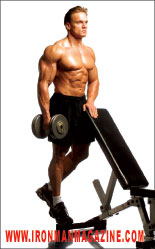 It’s time for an update on what the brothers have been doing since I took them under my charge a little over a year ago. Stelios is now 19 pounds of muscle heavier, and Yiannis 17. Their terrific progress testifies to the effectiveness of proper, drug-free training.
It’s time for an update on what the brothers have been doing since I took them under my charge a little over a year ago. Stelios is now 19 pounds of muscle heavier, and Yiannis 17. Their terrific progress testifies to the effectiveness of proper, drug-free training.
The physical change in the brothers has been considerable; moreover, they now have such purpose when they are in the gym. They really know how to train, and it’s given them tremendous confidence. The “train and hope” mentality they used to have is gone.
They know that their training will work provided they deliver in the gym—and also deliver on the components of recuperation when they’re out of it. They’ve become brilliant examples. In the gym they are absorbed by their training, but when they’re out of the gym, they get on with the rest of their lives. They eat perfectly every single day and sleep sufficiently every single night but without obsessing.
They still follow the format they adopted right from the start under my charge: an upper-body/lower-body split over three days a week—Mondays, Wednesdays and Fridays. That gives them four full rest days each week, which they need. So they train each bodypart three times every two weeks, which is once every four or five days.
Stelios’ lower-body routine has been side bends, barbell squats, leg curls, standing calf raises, partial stiff-legged deadlifts from knee height and machine back extensions. His upper-body routine consists of machine crunches, low-incline bench presses, seated back-supported dumbbell presses, seated shrugs, pulldowns, incline dumbbell curls and hand grippers.
Yiannis’ routines are the same except that instead of barbell squats and low-incline bench presses he does parallel-grip deadlifts using a hexagonal shrug bar and parallel-bar dips; and instead of partial stiff-legged deadlifts he does regular bent-legged deadlifts from the floor, reflecting his physical structure—longer limbs and a shorter torso than his brother has.
Recently we made two exercise changes. The brothers substituted one-legged calf raises for machine standing calf raises and seated EZ-curl-bar curls for incline dumbbell curls. With the one-legged calf raise, the lads could push themselves more than they could with the machine. They held the dumbbell on the same side as the leg being exercised and alternated legs.
They did EZ-curl-bar curls seated, with their backs supported on a near-vertical bench, making for partial reps, briefly resting the bar on their thighs at the bottom of each.
They had to drop Hammer seated shrugs because there was a problem with the Hammer machine. I had them do standing dumbbell shrugs instead—but they continued using the correct exercise technique: parallel grip, straight elbows and a high shrug on every rep with a momentary pause at both the top and bottom of the rep.
I didn’t keep the guys to a fixed set-rep format for their work sets, although there was never any variation on their warmup work. Here are the three work-set formats I used, which I rotated from workout to workout:
1) Two hard work sets on each exercise, with fewer reps on the second set.
2) A single work set to failure on each exercise. Rather than having them do two hard work sets per exercise, I’d push the brothers even harder on just one. They would typically do one, two or three reps more on a to-failure set than they would in their regular “hard” mode, but the compensation for the extra effort was fewer work sets in total.
3) Four work sets for each exercise, with the weight reduced slightly on each successive set, in order to maintain a steady rep count. I would change the weights between sets.
By rotating the three different work-set formats, the brothers got mental and physical variation while sticking with the same exercise selection so that they could most effectively focus on getting stronger on them all.
Although I placed great importance on poundage progression—through gradual weight increments using small weight plates—it was never at the cost of exercise technique. The brothers loved the gradual progressive-resistance mentality: “Inch by inch, training’s a cinch” has become their mantra.
Progressive resistance is the heart of bodybuilding because it’s a simple, quantifiable and incremental approach that’s easy to track. I had, however, explained to Yiannis and Stelios that it’s not the weight added to a given exercise that causes strength gain and possibly tissue growth. The ability to handle additional weight comes about only after the body has adapted to stimulation from previous workouts, which may include a tiny increase in muscle mass. Exaggerated focus on progressive weights is detrimental because it leads to degradation of exercise technique and rep-speed control, which should never be compromised just so you can add more weight to an exercise.
Because I supervise every workout, I ensure that their training is never “dirty.” Because hardly anyone has expert supervision to ensure that correct technique and rep speed are used, you must discipline yourself. That’s the bedrock of safe and effective training.
Combine correct technique, rep speed and range of motion with brief, hard training and proper recuperation. That will provide the best opportunity for the adaptations that produce increased strength and growth. IM
Editor’s note: Stuart McRobert’s first byline in IRON MAN appeared in 1981. He’s the author of the new 638-page opus on bodybuilding Build Muscle, Lose Fat, Look Great, available from Home Gym Warehouse (800) 447-0008 or www.Home-Gym.com.




















You must be logged in to post a comment Login